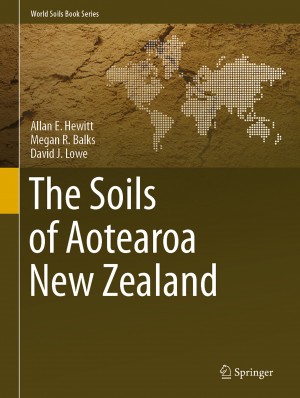Book Review: The Soils of Aotearoa New Zealand
Allan Hewitt, Megan Balks and David Lowe. Springer, 1st ed. 2021, 332 p. 192 illus., 147 illus. in colour.
As an ecologist fascinated with the role played by soils in the differentiation of native communities, plant traits and speciation of the flora I frequently pester soil scientists with questions about New Zealand soils and the influence they may have in the development of our unusual biota. So, I was delighted when Allan Hewitt, Megan Balks, and David Lowe produced a new book synthesising our knowledge of the soils of Aotearoa, placing them in an international context, and providing insights into the features that influence how the different soils are used today.
The book emphasises that soils form the dynamic interface between geology and the biosphere, moderated by climate. In Aotearoa, soil provides the basis for our diverse ecosystems, our natural capital, and our primary exports. Collectively, soils create the natural environment we enjoy in Aotearoa, sustaining much of our wealth. The first chapter provides an overview of fundamental soil forming factors (parent material, topography, climate, organisms, and time) before explaining, with useful diagrams, how soils are analysed, described, and compared. The New Zealand soil classification is a nested hierarchy, with 15 soil orders, 60 groups, and 250 subgroups. Multiple levels can be confusing, and the authors want to acknowledge how complex soils are in Aotearoa with considerable heterogeneity in many important soil-forming factors. However, a systematic taxonomic approach enables similar soils to be grouped and described to support soil mapping for policy, planning and land-use purposes. The chapter ends with a key and descriptions of the orders, highlighting distinguishing features.
Using Hewitt’s New Zealand soil classification as a framework, and with brief reference to international soil classification systems, the authors identify the extraordinary range of soils (orders) we have. The names of some orders (e.g. Ultic, Oxidic) may be unfamiliar but others (e.g. Pumice, Raw, Organic, Semi-arid) will be widely known. There is also recognition of Anthropic Soils, those created by humans where we have stripped and highly modified the original soil or infilled to develop agricultural or recreational opportunities or remediated sites after extractive use. There is comprehensive coverage of Aotearoa, extending to the Ross Sea region of Antarctica (Chapter 17) where we may find analogues for soil processes during glacial maxima in southern Aotearoa.
In Chapters 2–16 detailed accounts of each soil order are provided. These outline soil features, genesis, landscape association, properties (composition, chemical, physical, and biological), use and management. This comprehensive coverage makes the book accessible at several levels, depending on the reader’s interest. Sections on landscape and geography allow us to understand the origin and spatial pattern of soils where we live, the land use history, giving insight into the adaptability of different regions, while the detailed soil chemistry highlights how natural processes define limits and possibilities across the Aotearoa’s landscapes. The distinctive features of the soils outlined help us understand why different agricultural activities may be frustrated or facilitated by the soil properties in any region. Overall, we are shown how diverse, distinctive, and important the soils of Aotearoa have been in influencing settlement patterns, prosperity, and agriculture over the last 800 years.
The final chapter (18) provides a global context for understanding our soils, highlighting their relatively high soil carbon levels and largely acidic character, both partly reflecting prehuman forest dominance. Figure 18.2 summarising the relative age and origin of the different soils provides an important context for biologists interested in eco-evolutionary processes. The chapter also includes an account of Aotearoa’s remarkable history in soil mapping and assessing soil capability for land use planning, highlighting the recent development of specialist digital layers for soil information and precision agriculture. The distribution and vulnerability of elite, highly productive, and amenable soils are considered in relation to soil security to protect options in the future.
This book contains thought-provoking material for many interested in soils, from those seeking to understand the landscape, to those using soil to grow pasture and trees and crops, and to those wanting to make wise decisions about using soils for urban expansion or limiting natural hazards. Soils are described as biological engines, mixtures of bacteria, fungi, and invertebrate animals that influence and respond to mineral weathering and vascular plant composition and productivity. Hopefully, in future editions, we may have more of this information for Aotearoa to consider when utilising soils.
Finally, I want to congratulate Allan, Megan, and David on producing a wonderfully useful book that provides a benchmark and stimulus for understanding, exploring, utilising, and sustaining the remarkable soils of Aotearoa. This book is an enduring legacy of their significant contributions to soil science. It also establishes a strong case for both protecting and utilising our soils within natural limits to provide a sustainable basis for ongoing life in Aotearoa.


